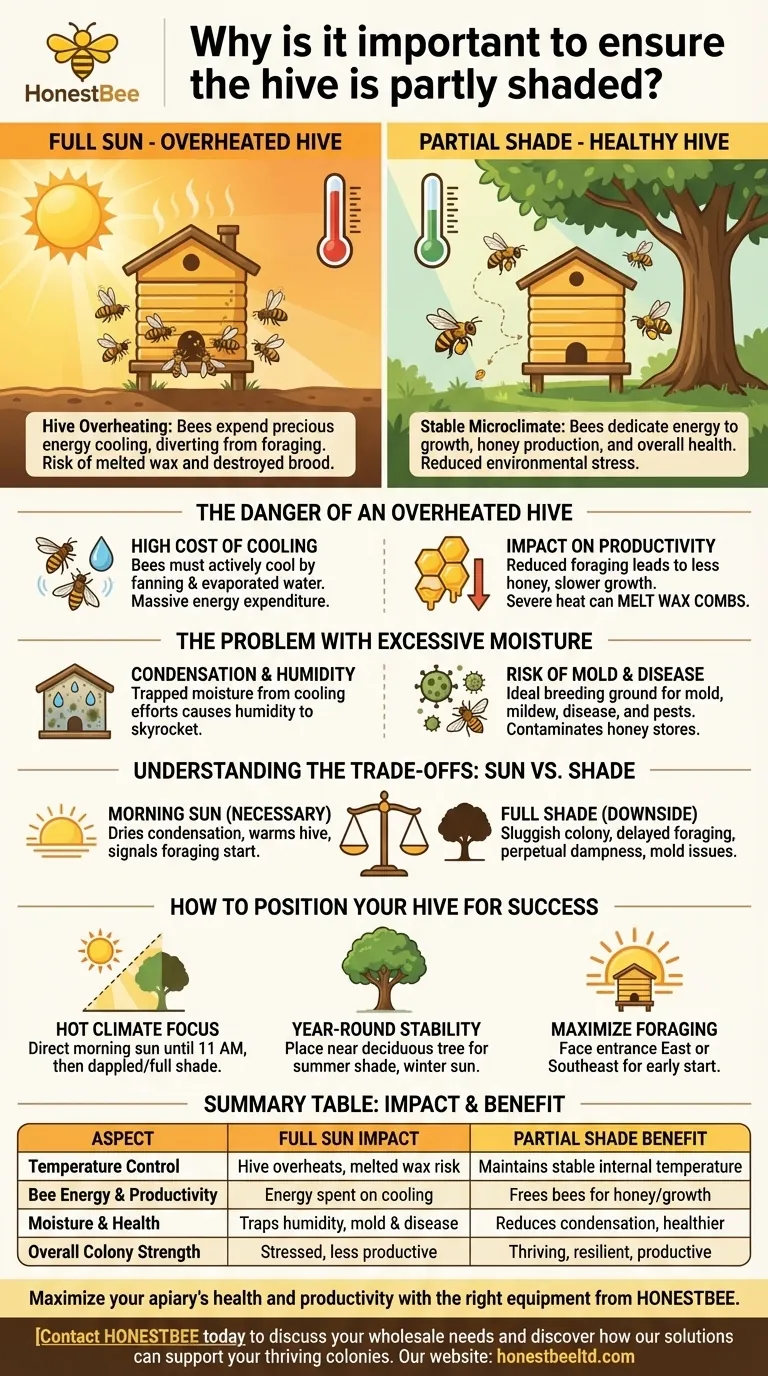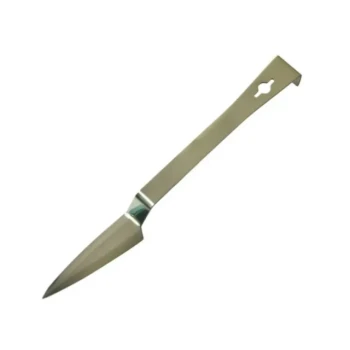Providing partial shade for a beehive is a critical step in managing its internal temperature and humidity. During hot summer months, relentless, direct sun can cause the hive to dangerously overheat. This forces the colony to expend precious energy on cooling efforts instead of vital tasks like foraging, which in turn leads to excessive moisture buildup and creates a prime environment for mold and disease.
The core principle of hive placement is to create a stable microclimate. Your goal is to minimize environmental stress on the colony, allowing the bees to dedicate their energy to growth, honey production, and overall health.

The Danger of an Overheated Hive
The High Cost of Cooling
A honeybee colony works tirelessly to maintain a stable internal temperature, particularly in the brood nest where young bees are developing.
When external temperatures soar, bees must actively cool the hive. They do this by fanning their wings at the entrance and foraging for water to spread within the hive for evaporative cooling.
The Impact on Productivity
This massive cooling effort diverts thousands of worker bees from essential tasks like foraging for nectar and pollen. This directly reduces the hive's productivity, resulting in less honey and slower colony growth.
In severe heat waves, the beeswax combs can soften or even melt. This catastrophic event can destroy brood, ruin honey stores, and compromise the entire structure of the hive.
The Problem with Excessive Moisture
Condensation and Humidity
A hot, poorly ventilated hive inevitably traps moisture. As bees respire and evaporate water for cooling, the internal humidity can skyrocket.
This moisture condenses on the inner surfaces of the hive, creating a damp, unhealthy environment for the colony.
The Risk of Mold and Disease
This pervasive dampness is an ideal breeding ground for mold and mildew. These fungi can contaminate honey stores and make them unfit for consumption by both bees and humans.
Furthermore, a persistently moist hive makes the colony more vulnerable to various diseases and pests that thrive in such conditions.
Understanding the Trade-offs: Sun vs. Shade
The Necessity of Morning Sun
While afternoon shade is critical for preventing overheating, placing a hive in full, constant shade is a significant mistake. Morning sun is equally important.
The early sun warms the hive after a cool night, drying out any condensation that formed overnight. It also serves as a crucial signal, encouraging the bees to begin their foraging flights earlier in the day.
The Downside of Full Shade
A hive located in perpetual shade often becomes sluggish and less productive. The bees may start foraging later and be less active overall.
This hive can also remain perpetually damp, leading to the same mold and disease issues caused by poor ventilation in the heat. The key is not total shade, but a strategic balance.
How to Position Your Hive for Success
The ideal placement uses the sun as a tool rather than fighting against it. Aim to provide sun in the morning and shade during the hottest part of the day.
- If your primary focus is managing a hot climate: Position your hive to receive direct morning sun until around 11 AM, ensuring it has dappled or full shade for the rest of the hot afternoon.
- If your primary focus is year-round stability: Place your hive near a deciduous tree. It provides essential shade from its leaves in the summer and allows the warming winter sun to reach the hive after the leaves have fallen.
- If your primary focus is maximizing foraging time: Ensure the hive entrance faces east or southeast (in the Northern Hemisphere) to capture the first rays of morning sun, encouraging an early start for the colony.
Thoughtful hive placement is one of the most effective and fundamental ways you can support the natural health and productivity of your colony.
Summary Table:
| Aspect | Impact of Full Sun | Benefit of Partial Shade |
|---|---|---|
| Temperature Control | Hive overheats, risking melted wax. | Maintains stable, safe internal temperature. |
| Bee Energy & Productivity | Bees expend energy cooling instead of foraging. | Frees bees for honey production and colony growth. |
| Moisture & Health | Traps humidity, promoting mold and disease. | Reduces condensation for a healthier environment. |
| Overall Colony Strength | Stressed, less productive colony. | Thriving, resilient, and more productive colony. |
Maximize your apiary's health and productivity with the right equipment from HONESTBEE. We supply durable, high-quality beekeeping supplies and equipment designed to help commercial apiaries and distributors like you create optimal hive conditions. From ventilation aids to protective gear, our wholesale-focused operations ensure you get the reliable tools needed for successful, sustainable beekeeping.
Contact HONESTBEE today to discuss your wholesale needs and discover how our solutions can support your thriving colonies.
Visual Guide

Related Products
- Langstroth Bee Hives Bee Keeping Box for Beginners Beekeeping
- HONESTBEE Professional Long Handled Hive Tool with Precision Cutting Blade
- HONESTBEE Advanced Ergonomic Stainless Steel Hive Tool for Beekeeping
- Professional Dual-End Stainless Steel Hive Tool for Beekeeping
- Professional Insulated Plastic Bee Hives
People Also Ask
- Why might a beginner be advised to start with a Langstroth hive? Unlock a Supportive Beekeeping Ecosystem
- What basic equipment is needed to start beekeeping? Your Essential Guide to a Confident Start
- Why were wooden hives traditionally preferred? For Natural Beekeeping Aligned with Bee Biology
- How does the orientation of the hive sides benefit comb construction? Ensure Straight, Movable Combs for Easier Hive Management
- What is the best type of bee hive for beginners? Start with the Proven Langstroth Standard



















